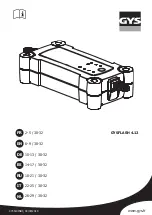
Do not continue driving without run-flat
tires
Do not continue driving if the vehicle is not
equipped with run-flat tires; continued driving
may result in serious accidents.◀
When a flat tire is indicated, DSC Dynamic Sta‐
bility Control is switched on if necessary.
Actions in the event of a flat tire
Normal tires
1.
Identify the damaged tire.
Do this by checking the air pressure in all
four tires.
If the tire inflation pressure in all four tires
is correct, the Flat Tire Monitor may not
have been initialized. In this case, initialize
the system.
If an identification is not possible, please
contact the service center.
2.
Rectify the flat tire.
Run-flat tires
You can continue driving with a damaged tire
at speeds up to 50 mph/80 km/h.
Continued driving with a flat tire
If continuing to drive with a damaged tire:
1.
Avoid sudden braking and steering maneu‐
vers.
2.
Do not exceed a speed of 50 mph/80 km/h.
3.
Check the air pressure in all four tires at
the next opportunity.
If the tire inflation pressure in all four tires
is correct, the Flat Tire Monitor may not
have been initialized. In this case, initialize
the system.
Possible driving distance with complete loss of
tire inflation pressure:
The possible driving distance after a loss of tire
inflation pressure depends on the cargo load
and the driving style and conditions.
For a vehicle containing an average load, the
possible driving distance is approx.
50 miles/80 km.
When the vehicle is driven with a damaged tire,
its handling characteristics change, e.g., re‐
duced lane stability during braking, a longer
braking distance, and altered self-steering
properties. Adjust your driving style accord‐
ingly. Avoid abrupt steering maneuvers or driv‐
ing over obstacles, e. g., curbs, potholes, etc.
Because the possible driving distance de‐
pends on how the vehicle is used during the
trip, the actual distance may be smaller or
greater depending on the driving speed, road
conditions, external temperature, cargo load,
etc.
Continued driving with a flat tire
Drive moderately and do not exceed a
speed of 50 mph/80 km/h.
A loss of tire inflation pressure results in a
change in the handling characteristics, e.g., re‐
duced lane stability during braking, a longer
braking distance and altered self-steering
properties.◀
Final tire failure
Vibrations or loud noises while driving
can indicate the final failure of the tire. Reduce
speed and stop; otherwise, pieces of the tire
could come loose and cause an accident. Do
not continue driving, and contact your service
center.◀
Tire Pressure Monitor TPM
The concept
The system monitors the tire pressure in the
four mounted tires. The system issues a warn‐
ing if there is a significant loss of pressure in
one or more tires. Sensors in the tire valves
measure the tire pressure.
Seite 79
Safety
Controls
79
Online Edition for Part no. 01 40 2 957 378 - X/14
Summary of Contents for Z4 2014
Page 2: ......
Page 10: ...Online Edition for Part no 01 40 2 957 378 X 14 ...
Page 17: ...Cockpit At a glance 17 Online Edition for Part no 01 40 2 957 378 X 14 ...
Page 18: ...Online Edition for Part no 01 40 2 957 378 X 14 ...
Page 110: ...Online Edition for Part no 01 40 2 957 378 X 14 ...
Page 120: ...Online Edition for Part no 01 40 2 957 378 X 14 ...
Page 135: ...Professional Radio Entertainment 135 Online Edition for Part no 01 40 2 957 378 X 14 ...
Page 136: ...Online Edition for Part no 01 40 2 957 378 X 14 ...
Page 150: ...Online Edition for Part no 01 40 2 957 378 X 14 ...
Page 155: ...Fuel Mobility 155 Online Edition for Part no 01 40 2 957 378 X 14 ...
Page 203: ...Indicator warning lamps Mobility 203 Online Edition for Part no 01 40 2 957 378 X 14 ...
Page 204: ...Online Edition for Part no 01 40 2 957 378 X 14 ...
Page 219: ......
















































